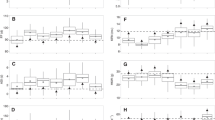Abstract
Key message
Inducing maize doubled haploids from F 2 plants (DHF2) instead of F 1 plants (DHF1) led to more recombination events. However, the best DHF2 lines did not outperform the best DHF1 lines.
Abstract
Maize (Zea mays L.) breeders rely on doubled haploid (DH) technology for fast and efficient production of inbreds. Breeders can induce DH lines most quickly from F1 plants (DHF1), or induce DH lines from F2 plants (DHF2) to allow selection prior to DH induction and have more recombinations. Our objective was to determine if the additional recombinations in maize DHF2 lines lead to a larger genetic variance and a superior mean of the best lines. A total of 311 DHF1 and 241 DHF2 lines, derived from the same biparental cross, were crossed to two testers and evaluated in multilocation trials in Europe and the US. The mean number of recombinations per genome was 14.48 among the DHF1 lines and 21.38 among the DHF1 lines. The means of the DHF1 and DHF2 lines did not differ for yield, moisture, and plant height. The genetic variance was higher among DHF2 lines than among DHF1 lines for moisture, but not for yield and plant height. The ratio of repulsion to coupling linkages, which was estimated from genomewide marker effects, was higher among DHF1 lines than among DHF2 lines for moisture, but not for yield and plant height. The higher genetic variance for moisture among DHF2 lines did not lead to lower moisture of the best 10 % of the lines. Our results indicated that the decision of inducing DH lines from F1 or F2 plants needs to be made from considerations other than the performance of the resulting DHF1 or DHF2 lines.

Similar content being viewed by others
Abbreviations
- DH:
-
Doubled haploid
- DHF1:
-
Doubled haploids induced from F1 plants
- DHF2:
-
Doubled haploids induced from F2 plants
- SNP:
-
Single nucleotide polymorphism
- QTL:
-
Quantitative trait loci
References
Arbelbide M, Bernardo R (2004) Random mating before selfing in maize BC1 populations. Crop Sci 44:401–404
Bates D, Maechler M, Bolker B, Walker S (2013) lme4: linear mixed-effects models using Eigen and S4. R package version 1:4
Bernardo R (2009) Should maize doubled haploids be induced among F1 or F2 plants? Theor Appl Genet 119:255–262
Covarrubias-Prieto J (1987) Genetic variability in F2 maize populations before and after random mating. Ph.D. dissertation, Iowa State University, Ames.
Endelman JB (2011) Ridge regression and other kernels for genomic selection with R package rrBLUP. Plant Genome 4:250–255
Haldane JBS, Waddington CH (1931) Inbreeding and linkage. Genetics 16:358–374
Jannink J-L, Abadie TE (1999) Inbreeding method effects on genetic mean, variance, and structure of recurrent selection populations. Crop Sci 39:988–997
Lande R, Thompson R (1990) Efficiency of marker-assisted selection in the improvement of quantitative traits. Genetics 124:743–756
Longin CFH (2008) Optimum allocation of test resources and comparison of alternative breeding schemes for hybrid maize breeding with doubled haploids. Doctoral dissertation, University of Hohenheim, Germany
Lu H, Romero-Severson J, Bernardo R (2002) Chromosomal regions associated with segregation distortion in maize. Theor Appl Genet 105:622–628
Melchinger AE, Geiger HH, Schnell FW (1986) Epistasis in maize (Zea mays L.). 2. Genetic effects in crosses among early flint and dent inbred lines determined by three methods. Theor Appl Genet 72:231–239
Melchinger AE, Schmidt W, Geiger HH (1988) Comparison of testcrosses produced from F2 and first backcross populations of maize. Crop Sci 28:743–749
Meuwissen THE, Hayes BJ, Goddard ME (2001) Prediction of total genetic value using genome-wide dense marker maps. Genetics 157:1819–1829
Ooijen JW, Voorrips RE (2002) JoinMap: version 3.0: software for the calculation of genetic linkage maps. Wageningen University and Research Center, The Netherlands
Riggs TJ, Snape JW (1977) Effects of linkage and interaction in a comparison of theoretical populations derived by diploidized haploid and single seed descent methods. Theor Appl Genet 49:111–115
Rober FK, Gordillo GA, Geiger HH (2005) In vivo haploid induction in maize-performance of new inducers and significance of doubled haploid lines in hybrid breeding. Maydica 50:275–283
Silva JC, Hallauer AR (1975) Estimation of epistatic variance in Iowa Stiff Stalk Synthetic maize. J Hered 66:290–296
Smith JSC, Hussain T, Jones ES, Graham G, Podlich D, Wall S, Williams H (2008) Use of doubled haploids in maize breeding: implications for intellectual property protection and genetic diversity in hybrid crops. Mol Breed. 22:51–59
Stuber CW, Moll RH (1971) Epistasis in maize (Zea mays L.). II. Comparison of selected with unselected populations. Genetics 67:137–149
Weir BS, Cockerham CC, Reynolds J (1980) The effects of linkage and linkage disequilibrium on the covariances of noninbred relatives. Heredity 45:351–359
Acknowledgments
We thank Raffaele Capitanio, Ben Ford, Donghong Pei, and Todd Warner for their assistance in providing the phenotypic and marker data.
Author information
Authors and Affiliations
Corresponding author
Ethics declarations
Conflict of interest
The authors declare no conflict of interest.
Additional information
Communicated by T. Lubberstedt.
Rights and permissions
About this article
Cite this article
Sleper, J.A., Bernardo, R. Recombination and genetic variance among maize doubled haploids induced from F1 and F2 plants. Theor Appl Genet 129, 2429–2436 (2016). https://doi.org/10.1007/s00122-016-2781-4
Received:
Accepted:
Published:
Issue Date:
DOI: https://doi.org/10.1007/s00122-016-2781-4




